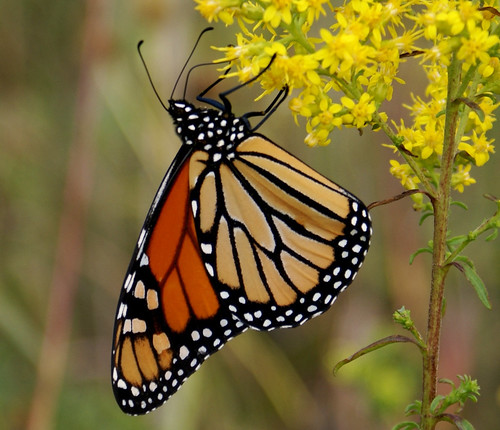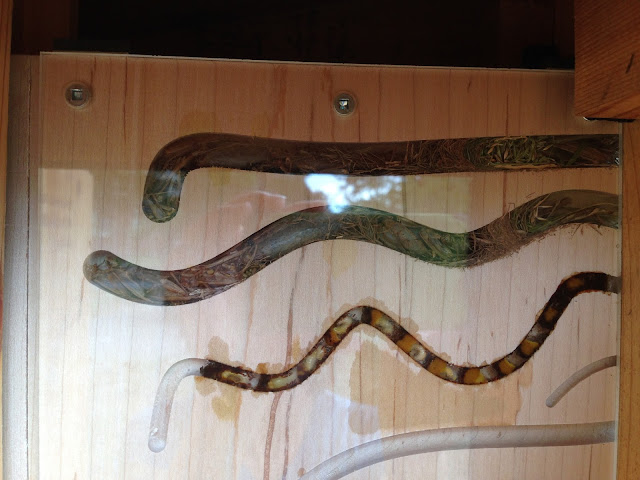Last summer, as I was working around campus with Sam Bahr, horticulturalist for the University of Maryland, I was shown various different gardens and landscapes around campus, varying in size and theme. We checked out different landscapes from Architecture and Van Munching, to Mayer Mall and Prince Frederick Hall. Along these walks, we discussed the different plants installed in landscapes as well as the concepts behind them.
My favorite garden we viewed was a very simple, yet incredibly naturalistic garden, a small planting bed behind Architecture. This garden, which is situated around a pyramid-like art piece, is intended to be prairie-themed with plants that are either native or "nativars," native plants which have been enhanced or changed in one way or another. Sam Bahr, the designer of the garden, is originally from eastern Kansas. He intended for this garden to mimic the tall grass prairies and grasslands that he was familiar with as he grew up.
In the bed, there is a mixture of prairie grass and different flowers. The grass, which was originally purple love grass, is now broom-sedge. The garden is intended to consist of a minimum of 70% grasses, and the remainder forbs. The forbs include aromatic aster(
Aster oblongifolius), purple coneflower (
Echinacea purpurea), lyre-leaf sage (
Salvia lyrata), smallhead blazing star (
Liatris microcephala), New York ironweed(
Vernonia noveboracensis), gaura(
Gaura lindheimeri), narrow-leaved sundrops(
Oenothera fruticosa) and whorled coreopsis (
Coreopsis verticillata).
 |
| Gaura blooming in early June |
This landscape instantly captured my heart for a multitude of reasons. Prior to even working in this garden, I noticed the way the planter didn't have any true "pattern" to how it was designed and I enjoyed this. As an urban forestry major, I enjoy naturalistic settings. When I am in a landscape, I enjoy having it be more organic and sporadic rather than being in patterns and straight lines, as that isn't how nature works. In this garden, even with the small space and architectural structure in the center, the plants themselves don't feel like they are being manipulated in one way or another to look "human made."
When I learned that Bahr had intended to make the garden to resemble the native prairies of his youth, it only made the planting that much more significant. While most planters are designed with the "thoughts" of the designer in mind, this planter went a bit further. Instead of simply putting out solely his "personal design preferences" Bahr designed the garden to be something that many people in this part of the US haven't had the opportunity to experience. It was designed with home in mind and the planting itself intends to show passersby the beauty that is the West.
Then, once I began helping maintain the planting, I actually found the maintenance not only easy, but in fact enjoyable (which is something I never thought I'd say about "weeding" and "pruning"). While there weren't a whole lot of "weeds" in the planter, as the grasses mostly shaded them out, there were hundreds upon hundreds of tiny little seedlings from the other plants in the garden. What we were doing in the garden was not necessarily clearing out all the seedlings, but picking and choosing which ones we believed should stay and go. I found this quite enjoyable as it felt like a form of art and not even work itself.
This planter, in addition to having deep sentimental value, also has multi-season features. While not much happens in the early spring, as the seasons begin to warm up, the different plants in this garden flower in varying colors and times. The lyre-leaf sage, one of the first plants to flower, has soft purple flowers. It flowers in Mid-May, as it is blooming now, and then develops lots of seeds which the goldfinches love to eat later in the season.
 |
| Picture of lyre-leaf sage in bloom May 15 |
After the sage, each of the other plants bloom in turn. The purple coneflower is one of the first to start blooming; however, it is quickly succeeded by the white gaura flowers, and the vibrant yellow flowers of common sundrop. The gaura will continue to bloom all through the summer into the fall, which is when the blazing star begin to bloom.
When the weather begins to cool, the blazing star and aromatic aster bloom. These continue to bloom well past when the other plants have started to go dormant and add bright color contrast to the fall color of the broomsedge.
Even after everything has gone dormant, the garden still holds interest for people passing by as the broomsedge will stay somewhat upright even after snow collects on the flower heads. This adds a combination of simultaneous fall and winter color.
In addition to this garden having multi-season interest, it is also low maintenance and ecologically beneficial. Due to the native plants in the garden, native birds, such as goldfinches, will utilize the seeds produced by the plants and not only disperse the seeds within the planting , but also spread the plants outside of the garden. The garden is also great habitat for other native plants. Just the other week, when looking over the garden, there was a new plant, a species of milkweed growing in the garden.
 |
| Milkweed plant 5/15 |
This garden helps attract wildlife and people alike. It includes multi-season interest and benefits wildlife in the area, two thing that I find very important. These drought tolerant plants only need water when first installed, and afterwards hardly ever need to be watered. The plants bring a new type of landscape to campus and show that a landscape can be both beautiful and low maintenance.
While I won't be able to enjoy the garden for much longer, as I will be graduating this Friday, May 22, I hope that others will be able to see this beautiful landscape grow and evolve in the years to come.













































